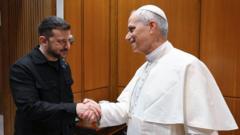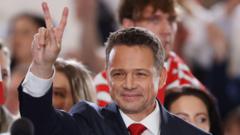As the Vatican conclave commenced its second day amid quiet anticipation, the 133 cardinals responsible for selecting the next pope are pushing forward with their deliberations. Following an inconclusive first vote on Wednesday, which produced black smoke and disappointment in St. Peter's Square, the cardinals reconvene on Thursday with high stakes as the world's 1.4 billion Catholics await news on their new leader.
**Papal Conclave Enters Second Day: Vatican Cardianls Resume Voting for Next Pope**

**Papal Conclave Enters Second Day: Vatican Cardianls Resume Voting for Next Pope**
The Vatican conclave continues with challenges as cardinals navigate a divided church landscape. The selection process, which requires a two-thirds majority, has begun its second day amid high public interest and potential delays.
The voting process is designed to be deeply secretive and secure, a tradition that has evolved over centuries. The conclave, which follows the death of Pope Francis in April, is the first in over a decade and has prompted considerable speculation regarding potential successors. The atmosphere is characterized by unfamiliar dynamics, as many of the cardinals were appointed by Francis and may not have established relationships with one another, possibly complicating consensus.
According to election norms, the cardinals will vote twice in the morning and twice in the afternoon until a two-thirds majority is achieved. With each round of voting, ballots will be incinerated, signaling the outcome through the color of smoke from the Sistine Chapel chimney: black for no decision made, and white to announce the election of a new pope. Historical precedents indicate that the conclave could conclude swiftly, given that the previous two popes were elected within two days.
Central themes of the conclave reflect a referendum on the legacy of Pope Francis. The new pope's stance will likely influence the church's direction amidst various pressures, including social inclusivism and an examination of past scandals. Cardianls are polarized between the establishment of continuing progressive policies or reversing advancements, expressing a spectrum of opinions significantly shaped by their prior experiences under Francis’ papacy.
Notably, the public wait is mirrored in St. Peter's Square, where crowds are expected to ebb and flow as the day progresses. Despite a lack of results, a few faithful are present, underscoring the historical gravity of the moment. This conclave exemplifies the dualities existing within the Roman Catholic Church, as it reckons with its past while seeking a path forward.
The eventual outcome of this conclave remains uncertain, but cardinals like Timothy M. Dolan indicate the process may take longer due to the unfamiliarity amongst its members. Others remain hopeful that consensus will be reached promptly. As the conclave unfolds, the world watches closely for the next chapter in the ongoing narrative of Catholic leadership.
As cardinals navigate this intricate election process, they must balance rigorous traditions with contemporary expectations, setting the stage for a future that steers in favor of either continuity or transformation within the Church.
According to election norms, the cardinals will vote twice in the morning and twice in the afternoon until a two-thirds majority is achieved. With each round of voting, ballots will be incinerated, signaling the outcome through the color of smoke from the Sistine Chapel chimney: black for no decision made, and white to announce the election of a new pope. Historical precedents indicate that the conclave could conclude swiftly, given that the previous two popes were elected within two days.
Central themes of the conclave reflect a referendum on the legacy of Pope Francis. The new pope's stance will likely influence the church's direction amidst various pressures, including social inclusivism and an examination of past scandals. Cardianls are polarized between the establishment of continuing progressive policies or reversing advancements, expressing a spectrum of opinions significantly shaped by their prior experiences under Francis’ papacy.
Notably, the public wait is mirrored in St. Peter's Square, where crowds are expected to ebb and flow as the day progresses. Despite a lack of results, a few faithful are present, underscoring the historical gravity of the moment. This conclave exemplifies the dualities existing within the Roman Catholic Church, as it reckons with its past while seeking a path forward.
The eventual outcome of this conclave remains uncertain, but cardinals like Timothy M. Dolan indicate the process may take longer due to the unfamiliarity amongst its members. Others remain hopeful that consensus will be reached promptly. As the conclave unfolds, the world watches closely for the next chapter in the ongoing narrative of Catholic leadership.
As cardinals navigate this intricate election process, they must balance rigorous traditions with contemporary expectations, setting the stage for a future that steers in favor of either continuity or transformation within the Church.




















